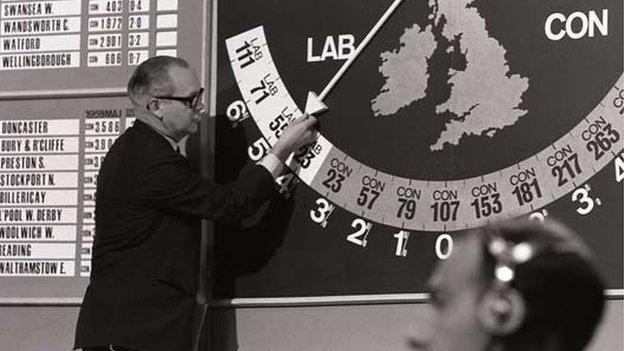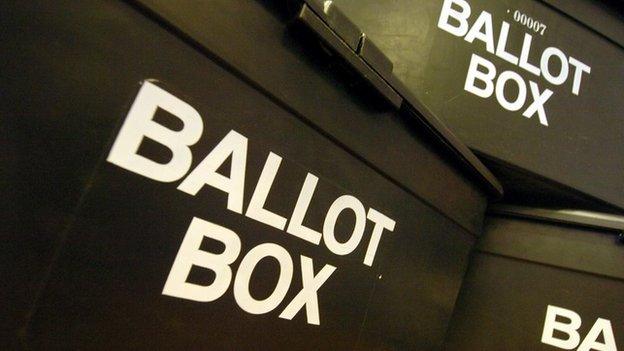Why this is a very local general election
- Published
- comments

Presenter Robert McKenzie with the swingometer on election night, 1964
Only people with long memories have clear recollections of simpler times when Professor Robert McKenzie's swingometer could tell the story of successive general elections.
Our part of the country has long been a two-party affair to a greater extent than anywhere else in the country, so a straightforward device pointing this way and then that was almost invariably quite good enough to do the job.
But what, I ask myself, would we need to visualise the infinite variety of 2015?
The best idea I have managed to come up with so far goes like this.
Imagine you suspend a needle from a thread above a table on which you position magnets of varying strengths and political colours in a circle.
Multi-party politics
They symbolise the interactions between the parties in each constituency.
Lower the needle towards the centre of the table and see which way it points. [Don't worry, BBC graphics designers, I'm not seriously thinking of doing this. Not yet at least!]
But the important point here is that the composition of the different magnets and their respective strengths would be very different from one constituency to another.
In this era of multi-party politics, every single seat is more or less a law unto itself.
Take for example two of our key local marginals, Dudley North and Solihull.
In the Black Country seat, Labour are defending a majority of just 649.
In 2010 their closest challengers were the Conservatives. This time, though, with nine seats on the local council its is UKIP who are breathing down Labour's neck.

How surprising would it really be if the election result itself were to spring the biggest surprise of all?
Solihull is another key Conservative target. The Liberal Democrats had a majority over them of just 175 last time round. But since then, the Green Party has established itself as a real force in the town, thanks to a potent combination of green belt and housing issues.
Extreme examples though they may be, these two constituencies reinforce the point that whether or not UKIP or the Greens succeed in winning seats themselves, or even come close to doing so, they will undoubtedly have significant and differing impacts on the established parties from one seat to another.
Curiouser and curiouser
Like a collection of by-elections perhaps?
That may be overstating it. But I am becoming increasingly convinced that this election offers us regional and local broadcasters a unique opportunity to explore the local dynamics of individual seats and to explain the possibility that in the shake-out of seats between the biggest parties it is not unreasonable to envisage gains and losses in both directions.
And what does this tell us about those headline national poll ratings pointing to a hung Parliament, in which the two biggest parties in lock step with each other followed by UKIP, the Liberal Democrats and then the Greens?
Or, about those "percentage swing to win or lose" statistics which have been calculated in a predominantly two-party environment?
All it tells us is how little they tell us.
"Never assume" said the recently-departed doyen of cricket commentators Richie Benaud.
In an election as unpredictable as this, maybe the assumptions about a hung Parliament are themselves suspect. Maybe the answer lies not in the macro but in the micro.
In this contest so full of unexpected twists and turns, how surprising would it really be if the result itself were to spring the biggest surprise of all?